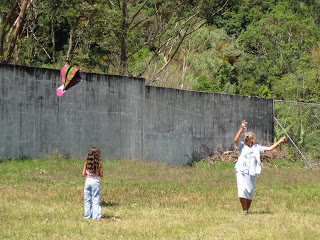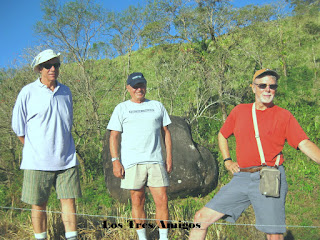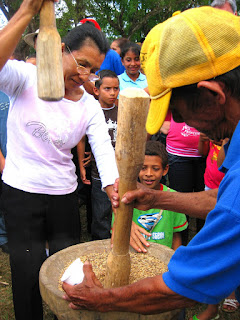
Yes, yes, we do watch this stuff here in Boquete. What expat would not root for their favorite team? I went to The Rotary Club of Boquete Fundraiser on Sunday to watch the game and to check out the card tables and support another good cause.
Club Rotario de Boquete has about 24 members - is part of the larger organization, Rotary International. The object of Rotary is to encourage and foster the idea of service to the local community. The Rotary works directly in the community with other clubs throughout the world to influence and maximize the quality of these services. Club Rotario de Boquete has built and continues to build relationships with Clubs in the US, Canada, Spain, and Panamá. With help from other clubs, there is the ability to aid more people in need and unite people of different cultures and beliefs.

All Rotarians work daily to make the world a better place in which we can all live peacefully. In Boquete, it has sponsored the Medical Clinic at Casa Esperanza, Casa Hogar Triskar, an orphanage for children abandoned or parents cannot care for their child and various schools in the Boquete area.
Five dollars was the fundraisers admittance in return we received a raffle ticket for a chance to win “dinner for two” at one of the swankier places here called "The Panamonte." The owner is Inga Collins whose parents the purchased The Panamonte in 1946.
The games played were Black Jack, Poker -

the dealers were busy all evening, and five dollars for the game pool - surely the Rotary Club
made money for their charitable cause. A friend of mine won more than twenty-five dollars playing poker table - he decided to take the money instead of losing, hum, smart man.

Hamburgers were grilling outside and tasted delicious, I ate the best Panamanian hot dog since my arrival. Oh and let me not forget to write a bit about the Super Bowl game. It was definitely an exciting game - some were seated on the edge of their chairs as the Pittsburgh Steelers scored a touchdown with 35 seconds left and beat the Cardinals by 27 points to 23. What a performance!
The Rotary Club’s Super Bowl fundraiser organized primarily by Jerry Wager took place in
“La Cabaña”, the only good late nightspot in Boquete. It looks like a huge cabin lodge high up in the north woods in the United States. Frédéric Bourjalliat is one of the owners who has decorated La Cabaña, with module red and black sofas and lounge chairs for very comfy seating. On a typical weekend La Cabaña is usually filled with a few older folks but it is a mostly young crowd who listen to their favorite beat “reggaetón” and other good music beats blasting out from the sound system. La Cabaña is really a cool two level place to hangout.

Frédéric's staff is always attentive to customers, drinks priced reasonably at a dollar fifty or so for a glass of Panamanian Ron (rum) on the rocks or with your choice of mixer . Frédéric said his rum selection is vast and he has many other liquor choices too. When you come to visit Boquete or here for the weekend only check out La Cabaña, they are open until the wee hours (weekends only) of the morning, similar to the rave bars in the states.
Today is a rainy and very windy day in Boquete this storm is hitting Panama from different areas. It started from the East Coast in the US and over the Atlantic. I wanted to have a better pic of
La Cabaña, but with this weather; it would be impossible to take a good shot and will not show as well. In another day or so, we will have good weather again and will post a pic of La Cabaña then.
Asi es la vida, C’est la vie, o Questa è la vita. Some days are fantastic! Some days are good!

 While going through my e-mail this morning I read about the “Festival of Kites” the Mayor of Boquete Manolo Ruiz would be handing out 300 “cometas” kites at the Los Naranjos Gym today.
While going through my e-mail this morning I read about the “Festival of Kites” the Mayor of Boquete Manolo Ruiz would be handing out 300 “cometas” kites at the Los Naranjos Gym today. It sounded like fun and a chance to take some pictures doe a short posting on my blog- so I decided to go. Both children and the “young at heart” were enjoying their kite flying some better at it than others. It was a beautiful day for this activity, the sky was blue, the sun was out, and just enough wind to get the kites up in the air.
It sounded like fun and a chance to take some pictures doe a short posting on my blog- so I decided to go. Both children and the “young at heart” were enjoying their kite flying some better at it than others. It was a beautiful day for this activity, the sky was blue, the sun was out, and just enough wind to get the kites up in the air. “Festival of Kites.”
“Festival of Kites.” 






























 Hamburgers were grilling outside and tasted delicious, I ate the best Panamanian hot dog since my arrival. Oh and let me not forget to write a bit about the Super Bowl game. It was definitely an exciting game - some were seated on the edge of their chairs as the Pittsburgh Steelers scored a touchdown with 35 seconds left and beat the Cardinals by 27 points to 23. What a performance!
Hamburgers were grilling outside and tasted delicious, I ate the best Panamanian hot dog since my arrival. Oh and let me not forget to write a bit about the Super Bowl game. It was definitely an exciting game - some were seated on the edge of their chairs as the Pittsburgh Steelers scored a touchdown with 35 seconds left and beat the Cardinals by 27 points to 23. What a performance!